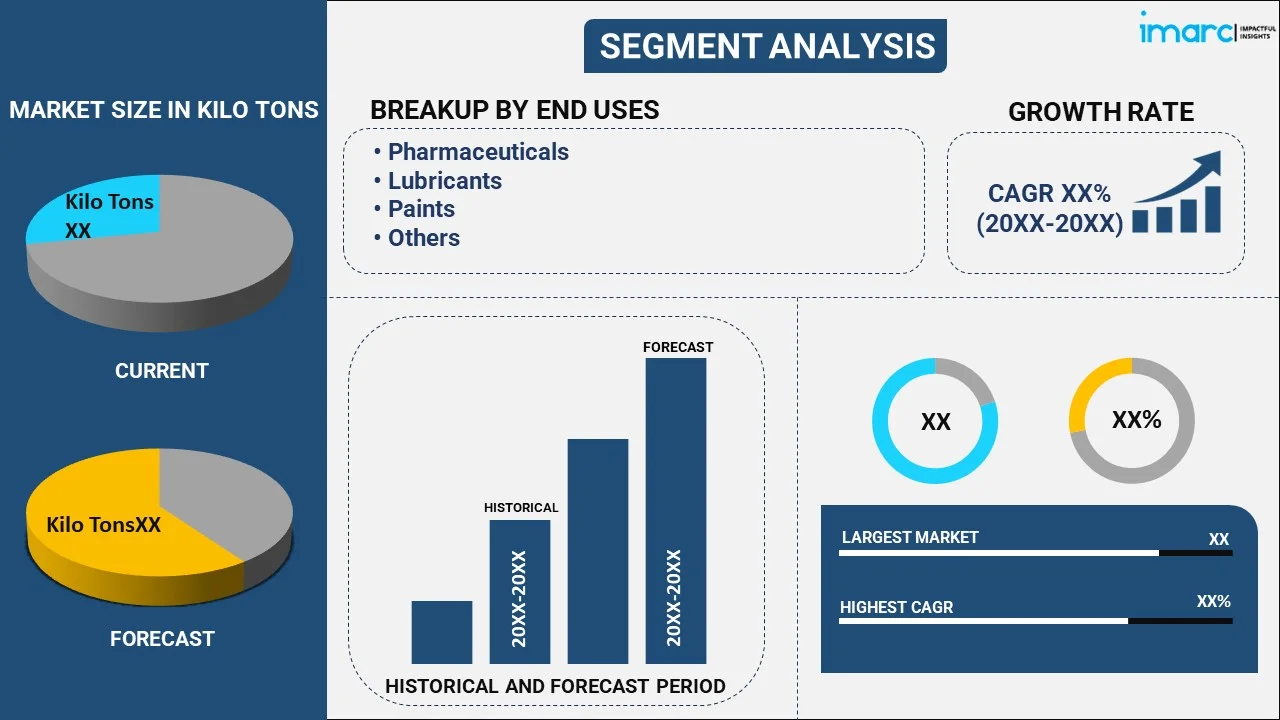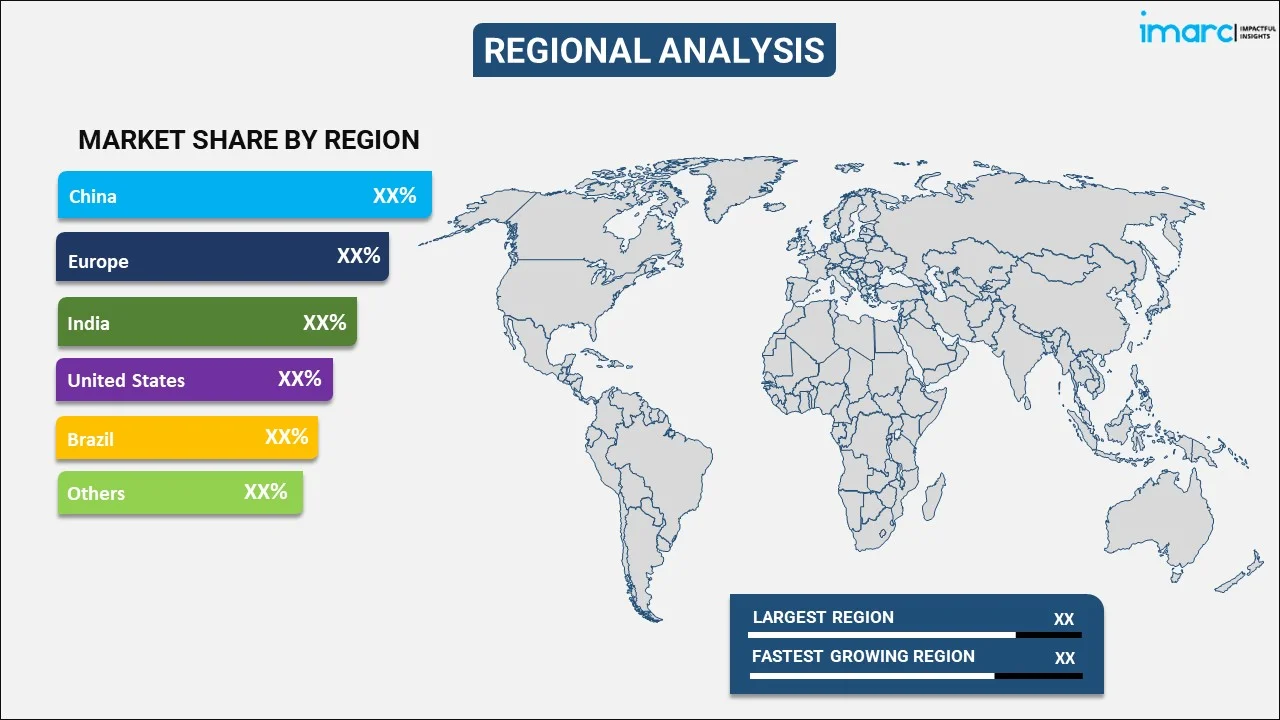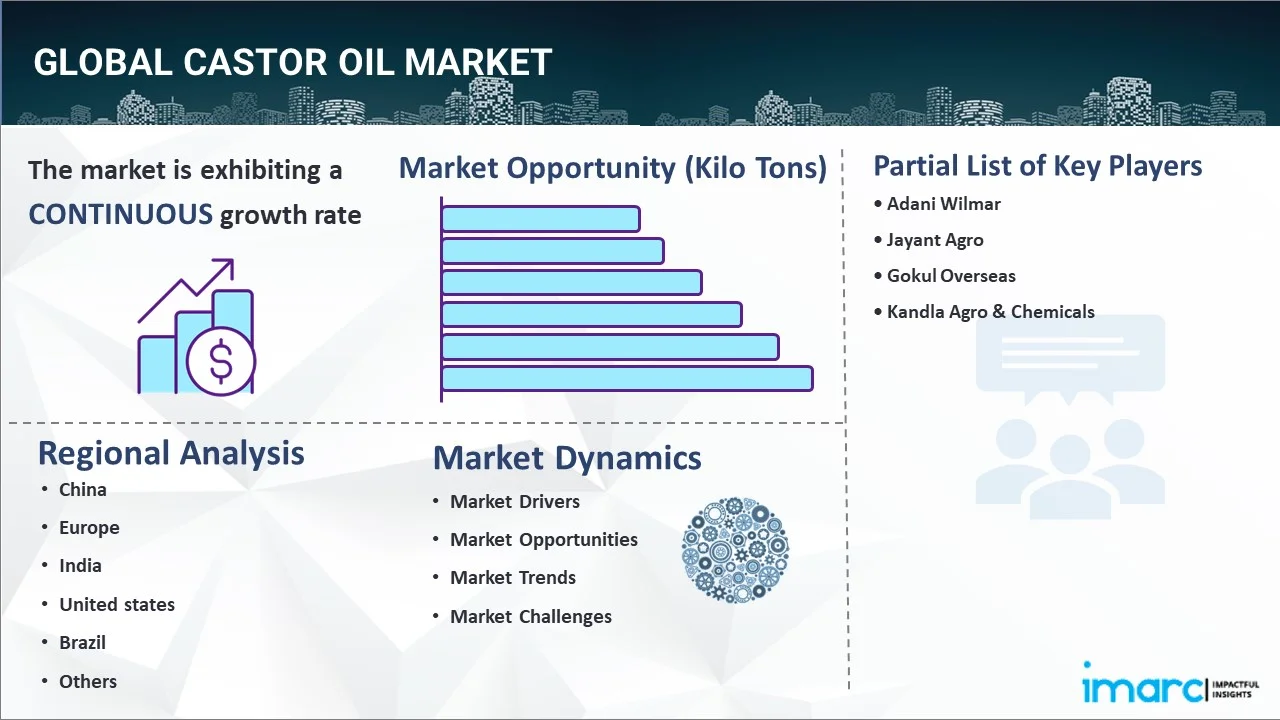
Castor Oil Market Report by End Use (Pharmaceuticals, Lubricants, Paints, Soaps, and Others), and Region 2025-2033
Castor Oil Market, 2024 Size and Share:
The global castor oil market size reached 803.7 Kilo Tons in 2024. Looking forward, IMARC Group expects the market to reach 883.4 Kilo Tons by 2033, exhibiting a growth rate (CAGR) of 1.1% during 2025-2033. The increasing renewable energy initiatives, along with the expanding industrial applications, are primarily propelling the market growth.
|
Report Attribute
|
Key Statistics
|
|---|---|
|
Base Year
|
2024
|
|
Forecast Years
|
2025-2033
|
|
Historical Years
|
2019-2024
|
|
Market Size in 2024
|
803.7 Kilo Tons |
|
Market Forecast in 2033
|
883.4 Kilo Tons |
| Market Growth Rate 2025-2033 | 1.1% |
Castor Oil Market Analysis:
- Major Market Drivers: Extensive applications of castor oil in numerous industries, such as personal care, chemicals, pharmaceuticals, lubricants, etc., owing to its unique properties and versatility, are primarily driving the market.
- Key Market Trends: Continuous innovations in refining processes, extraction methods, and agricultural practices are among the emerging trends stimulating the market. Moreover, the elevating production efficiency and quality is contributing to higher yields and enhanced product quality.
- Geographical Trends: China exhibits a clear dominance in the overall market. This can be attributed to supportive government policies and investments. Additionally, favorable climatic conditions, along with the easy availability of raw materials will continue to fuel the castor oil market growth across the country over the forecasted period.
- Competitive Landscape: Some of the key players in the global market include Adani Wilmar, Jayant Agro, Gokul Overseas, and Kandla Agro & Chemicals, among many others.
- Challenges and Opportunities: Supply chain disruptions, coupled with fluctuations in castor seed prices, are among the challenges hindering the market. However, the rising need for bio-based products, owing to increasing environmental concerns, is one of the significant opportunities bolstering the global market.
Castor Oil Market Trends:
Sustainability and Regulatory Initiatives
As various industries and government bodies are inclining towards environmentally friendly practices, there is an inflating focus on finding renewable resources. This, in turn, is propelling the product usage, as it is biodegradable, and its production has a lower carbon footprint as compared to various synthetic alternatives. Additionally, there are various opportunities to support growers and contribute to improved outcomes via the environmental, social, and governance impacts of farming. Moreover, the launch of favorable policies by government bodies to promote the adoption of eco-friendly products is also acting as another significant growth-inducing factor. For instance, India launched the World Castor Sustainability Forum (WCSF) to ensure a sustainable and traceable castor supply chain, benefiting the environment, economy, and smallholder producers. Key industry players and international buyers have joined this initiative. Thirty Farmer Producer Organizations, representing 25,000 farmers, will collaborate with WCSF to promote sustainable practices. WCSF aims to enhance India's leadership in the global sustainability movement while supporting economic growth and social responsibility.
Rising Biofuel Production
The elevating inclination among industry players towards castor oil as a feedstock for the production of biofuel and biopolymers, on account of its high ricinoleic acid content, which makes it an efficient fuel source, is one of the key factors driving the market. For example, in June 2023, Casterra Ag Ltd., a subsidiary of Evogene Ltd., signed a framework agreement to sell seeds of its proprietary castor varieties to one of the world's leading oil and gas companies for cultivation in specific territories across Africa, which is augmenting the castor oil market outlook. In line with this, the strategic agreements by Casterra, which is one of the biotech companies based in Rehovot, are expected to contribute approximately 400 tons to Casterra's production output in 2024 while establishing long-term production infrastructures. Furthermore, by expanding the network of seed producers in several locations, the company aims to mitigate the risk of single-source dependency.
Increasing Industrial Applications
Castor oil is extensively used in several sectors, particularly as a feedstock for high-performance chemicals and materials. Additionally, it is a source of 12-hydroxystearic acid (12-HSA), which is a crucial raw material in the manufacturing of plastics, specialty chemicals, polymers, etc. Moreover, these chemicals are widely adopted in numerous industries, including aviation, automotive, consumer electronics, etc. Apart from this, the elevating role in the production of polyurethane and its derivatives also catalyzes the castor oil market revenue. For instance, in April 2021, Arkema, one of the leading manufacturers of amino 11 derived from castor oil, built an integrated bio-factory dedicated to high-performance polymers in Singapore. Apart from this, the plant increased polyamide 11 global production capacity by 50%, in full accordance with a circular economy approach. As such, castor oil is gaining traction in the chemical industry, which is acting as another significant growth-inducing factor. One of the studies by Zhang et al. reported that the best emulsifier formula to achieve castor oil stable emulsion is a mixture of sorbitan monooleate and polyoxyethylene sorbitan monostearate.
Castor Oil Market Segmentation:
IMARC Group provides an analysis of the key trends in each segment of the market, along with castor oil market forecast at the global, regional, and country levels for 2025-2033. Our report has categorized the market based on the end use.
Breakup by End Use:

- Pharmaceuticals
- Lubricants
- Paints
- Soaps
- Others
Pharmaceuticals accounts for the majority of the market share
The report has provided a detailed breakup and analysis of the market based on the end use. This includes pharmaceuticals, lubricants, paints, soaps, and others. According to the report, pharmaceuticals accounted for the largest market segmentation.
The widespread adoption of castor oil in the pharmaceutical industry, owing to its potential health benefits and versatile properties, is driving the market growth. Furthermore, its primary role as a stimulant laxative assist in relieving constipation. Additionally, castor oil is utilized in several pharmaceutical preparations, including ointments, creams, topical medications, etc. Its antimicrobial and anti-inflammatory properties make it suitable for treating skin conditions, such as eczema, acne, fungal infections, etc. Apart from this, researchers are also exploring the potential of castor oil in drug delivery systems, where it can efficiently deliver medications and encapsulate. The surging demand for organic and plant-based ingredients in the pharmaceuticals sector, paired with the increasing awareness of castor oil's advantages and versatility, is creating new growth opportunities for the market participants. The combination of castor oil in advanced therapeutic solutions is expected to boost the traction of the product demand.
Breakup by Region:

- China
- Europe
- India
- United states
- Brazil
- Others
China leads the market, accounting for the largest castor oil market share
The market research report has also provided a comprehensive analysis of all the major regional markets, which include China, Europe, India, United States, Brazil, others. According to the report, China accounted for the largest market share.
The escalating adoption of castor oil to relieve several health concerns, owing to its therapeutic, preventive, and curative properties, is strengthening the market in China. Apart from this, due to the anti-inflammatory and anti-bacterial attributes of castor oil, it is extensively used as a massage oil to ease nerve inflammations, arthritic joints, sore muscles, etc. Moreover, the rising investments in processing facilities to enhance yield and quality are acting as significant growth-inducing factors across the country. In line with this, various companies and research institutes are exploring high-yield crop varieties and innovative extraction methods to stay competitive, which is stimulating the market in China. As per Volza’s China Export data, the country exports its castor oil to the United States, Vietnam, and Germany. Consequently, government bodies are launching policies, such as reduced tariffs, trade agreements, and streamlined customs procedures to provide a competitive edge in the market. Besides this, the wide presence of key manufacturers and suppliers of castor oil across the country, such as Hebei Jingbo New Material Technology Co., Ltd., Hebei Mojin Biotechnology Co., Ltd., Hebei Yanxi Chemical Co., Ltd., etc., will continue to drive the castor oil market's recent opportunities across China in the coming years.
Competitive Landscape:
The key players in the market are actively engaging in several strategic initiatives to capitalize on the growing demand and expand their market presence. They are investing in research and development to enhance production techniques, improve the quality of castor oil, and explore new applications. Additionally, these companies are focusing on sustainability by promoting responsible sourcing, reducing environmental impact, and participating in renewable energy projects. According to the castor oil market overview, they also collaborate with industries, such as cosmetics, pharmaceuticals, and biofuels, to develop innovative solutions. In a competitive market, these key players continually innovate, adapt, and expand their product offerings to meet the evolving needs of various industries and consumers.
The market research report has provided a comprehensive analysis of the competitive landscape. Detailed profiles of all major companies have also been provided. Some of the key players in the market include:
- Adani Wilmar
- Jayant Agro
- Gokul Overseas
- Kandla Agro & Chemicals
(Please note that this is only a partial list of the key players, and the complete list is provided in the report.)
Castor Oil Market Recent Developments:
- March 2024: Casterra Ag Ltd., which is one of the integrated solutions companies for growing castor seeds for bio-based industries and a subsidiary of Evogen Ltd., is taking significant steps to strengthen its castor production capabilities. The company recently signed strategic agreements with new and existing seed producers in Africa and Brazil to increase its production capabilities of high-yielding castor seeds.
- March 2024: In an interview with HT Lifestyle, Dr. Stuti Khare Shukla, the founder of Elements of Aesthetics and FDA-approved Hair Growth Booster, promoted the use of certain oils, including castor oil, to improve the health of the hair and scalp.
- February 2024: Some of the researchers, including Catherine Jennings, at the University of Auckland, are running a trial of castor oil as a potentially safe and natural treatment for dry-eye disease by following a successful pilot study.
Castor Oil Market Report Scope:
| Report Features | Details |
|---|---|
| Base Year of the Analysis | 2024 |
| Historical Period | 2019-2024 |
| Forecast Period | 2025-2033 |
| Units | Million USD, ‘000 Tons |
| Scope of the Report | Exploration of Historical Trends and Market Outlook, Industry Catalysts and Challenges, Segment-Wise Historical and Future Market Assessment:
|
| End Uses Covered | Pharmaceuticals, Lubricants, Paints, Soaps, Others |
| Regions Covered | China, Europe, India, United States, Brazil, Others |
| Companies Covered | Adani Wilmar, Jayant Agro, Gokul Overseas, Kandla Agro & Chemicals, etc. |
| Customization Scope | 10% Free Customization |
| Post-Sale Analyst Support | 10-12 Weeks |
| Delivery Format | PDF and Excel through Email (We can also provide the editable version of the report in PPT/Word format on special request) |
Key Benefits for Stakeholders:
- IMARC’s industry report offers a comprehensive quantitative analysis of various market segments, historical and current market trends, market forecasts, and dynamics of the castor oil market from 2019-2033.
- The research report provides the latest information on the market drivers, challenges, and opportunities in the global castor oil market.
- The study maps the leading, as well as the fastest-growing, regional markets.
- Porter's five forces analysis assists stakeholders in assessing the impact of new entrants, competitive rivalry, supplier power, buyer power, and the threat of substitution. It helps stakeholders to analyze the level of competition within the castor oil industry and its attractiveness.
- The competitive landscape allows stakeholders to understand their competitive environment and provides insight into the current positions of key players in the market.
Key Questions Answered in This Report
The global castor oil market reached a volume of 803.7 Kilo Tons in 2024.
The rising utilization of castor oil in the production of cosmetics, medicines, toiletries, polyurethane adhesives, machining oils, refrigeration lubricants, etc., represents one of the key factors catalyzing the global castor oil market.
The sudden outbreak of the COVID-19 pandemic has led to the changing consumer inclination from conventional brick-and-mortar distribution channels towards online retail platforms for the purchase of castor oil.
Based on the end use, the global castor oil market can be divided into pharmaceuticals, lubricants, paints, soaps and others. Among these, the pharmaceutical sector currently accounts for the majority of the total market share.
On a regional level, the market has been classified into China, Europe, India, the United States, Brazil and others. where China currently dominates the global market.
Some of the major castor oil market companies include Adani Wilmar, Jayant Agro, Gokul Overseas, Kandla Agro & Chemicals, etc.
Pharmaceuticals end use accounted for the largest castor oil market share.
Need more help?
- Speak to our experienced analysts for insights on the current market scenarios.
- Include additional segments and countries to customize the report as per your requirement.
- Gain an unparalleled competitive advantage in your domain by understanding how to utilize the report and positively impacting your operations and revenue.
- For further assistance, please connect with our analysts.

 Inquire Before Buying
Inquire Before Buying
 Speak to an Analyst
Speak to an Analyst
 Request Brochure
Request Brochure
 Request Customization
Request Customization




.webp)




.webp)












